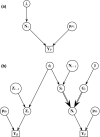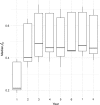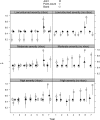Precision gain versus effort with joint models using detection/non-detection and banding data
- PMID: 30766670
- PMCID: PMC6362443
- DOI: 10.1002/ece3.4825
Precision gain versus effort with joint models using detection/non-detection and banding data
Abstract
Capture-recapture techniques provide valuable information, but are often more cost-prohibitive at large spatial and temporal scales than less-intensive sampling techniques. Model development combining multiple data sources to leverage data source strengths and for improved parameter precision has increased, but with limited discussion on precision gain versus effort. We present a general framework for evaluating trade-offs between precision gained and costs associated with acquiring multiple data sources, useful for designing future or new phases of current studies.We illustrated how Bayesian hierarchical joint models using detection/non-detection and banding data can improve abundance, survival, and recruitment inference, and quantified data source costs in a northern Arizona, USA, western bluebird (Sialia mexicana) population. We used an 8-year detection/non-detection (distributed across the landscape) and banding (subset of locations within landscape) data set to estimate parameters. We constructed separate models using detection/non-detection and banding data, and a joint model using both data types to evaluate parameter precision gain relative to effort.Joint model parameter estimates were more precise than single data model estimates, but parameter precision varied (apparent survival > abundance > recruitment). Banding provided greater apparent survival precision than detection/non-detection data. Therefore, little precision was gained when detection/non-detection data were added to banding data. Additional costs were minimal; however, additional spatial coverage and ability to estimate abundance and recruitment improved inference. Conversely, more precision was gained when adding banding to detection/non-detection data at higher cost. Spatial coverage was identical, yet survival and abundance estimates were more precise. Justification of increased costs associated with additional data types depends on project objectives.We illustrate a general framework for evaluating precision gain relative to effort, applicable to joint data models with any data type combination. This framework evaluates costs and benefits from and effort levels between multiple data types, thus improving population monitoring designs.
Keywords: abundance; data integration; integrated population models; recruitment; study design; survival; western bluebird; wildfire effects.
Figures






References
-
- Arnason, A. N. , Schwarz, C. J. , & Gerrard, J. M. (1991). Estimating closed population size and number of marked animals from sighting data. The Journal of Wildlife Management, 55(4), 716–730. 10.2307/3809524 - DOI
-
- Besbeas, P. , Lebreton, J.‐D. , & Morgan, B. J. T. (2003). The efficient integration of abundance and demographic data. Journal of the Royal Statistical Society. Series C (Applied Statistics), 52(1), 95–102. 10.1111/1467-9876.00391 - DOI
-
- Block, W. M. , Strohmeyer, B. E. , & Sanderlin, J. S. (2018). Northern Arizona, USA, post-wildfire avian data: Western bluebird detection/non‐detection and banding data. Fort Collins, CO: Forest Service Research Data Archive; 10.2737/RDS-2018-0040 - DOI
LinkOut - more resources
Full Text Sources

